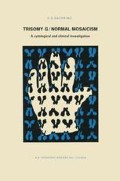Abstract
Down’s syndrome patients have an extra G chromosome in all their cells, whereas the trisomy G/normal mosaic patients have this extra chromosome only in some of their cells. For this reason, a direct relationship between any measurable sign of Down’s syndrome and the extra G chromosome could be expected to result in an occurrence of that sign in mosaic patients in a degree proportional to the percentage of trisomic cells, while non-measurable clinical signs would only appear in a percentage of mosaic patients.
Access this chapter
Tax calculation will be finalised at checkout
Purchases are for personal use only
Rights and permissions
Copyright information
© 1971 Springer Science+Business Media Dordrecht
About this chapter
Cite this chapter
Sachs, E.S. (1971). Summary. In: Trisomy G/Normal Mosaicism. Springer, Dordrecht. https://doi.org/10.1007/978-94-010-2956-8_5
Download citation
DOI: https://doi.org/10.1007/978-94-010-2956-8_5
Publisher Name: Springer, Dordrecht
Print ISBN: 978-90-207-0311-5
Online ISBN: 978-94-010-2956-8
eBook Packages: Springer Book Archive

